|
PLearn 0.1
|
|
PLearn 0.1
|
The first sentence should be a BRIEF DESCRIPTION of what the class does. More...
#include <RBMTrainer.h>
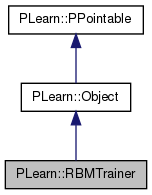
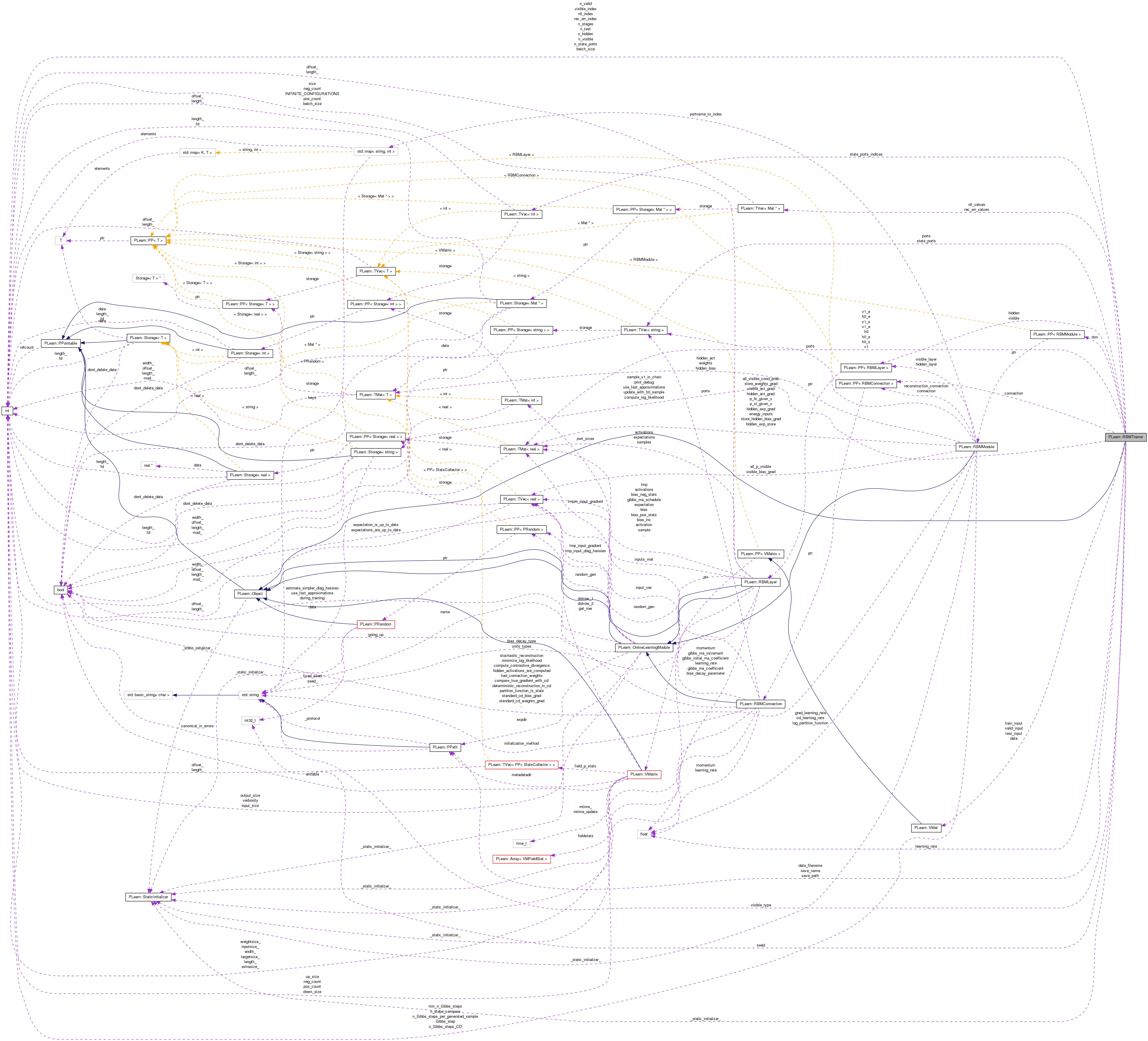
Public Member Functions | |
| RBMTrainer () | |
| Default constructor. | |
| Mat | NLL (const Mat &examples) |
| Mat | recError (const Mat &examples) |
| void | CD1 (const Mat &examples) |
| virtual void | run () |
| Override this for runnable objects (default method issues a runtime error). | |
| virtual string | classname () const |
| virtual OptionList & | getOptionList () const |
| virtual OptionMap & | getOptionMap () const |
| virtual RemoteMethodMap & | getRemoteMethodMap () const |
| virtual RBMTrainer * | deepCopy (CopiesMap &copies) const |
| virtual void | build () |
| Post-constructor. | |
| virtual void | makeDeepCopyFromShallowCopy (CopiesMap &copies) |
| Transforms a shallow copy into a deep copy. | |
Static Public Member Functions | |
| static string | _classname_ () |
| static OptionList & | _getOptionList_ () |
| static RemoteMethodMap & | _getRemoteMethodMap_ () |
| static Object * | _new_instance_for_typemap_ () |
| static bool | _isa_ (const Object *o) |
| static void | _static_initialize_ () |
| static const PPath & | declaringFile () |
Public Attributes | |
| int | n_visible |
| ### declare public option fields (such as build options) here Start your comments with Doxygen-compatible comments such as //! | |
| int | n_hidden |
| string | visible_type |
| bool | update_with_h0_sample |
| bool | sample_v1_in_chain |
| bool | compute_log_likelihood |
| int | n_stages |
| real | learning_rate |
| int32_t | seed |
| int | n_train |
| int | n_valid |
| int | n_test |
| int | batch_size |
| PPath | data_filename |
| PPath | save_path |
| PPath | save_name |
| bool | print_debug |
| bool | use_fast_approximations |
Static Public Attributes | |
| static StaticInitializer | _static_initializer_ |
Static Protected Member Functions | |
| static void | declareOptions (OptionList &ol) |
| Declares the class options. | |
| static void | declareMethods (RemoteMethodMap &rmm) |
| Declare methods that are intended to be remote-callable. | |
Protected Attributes | |
| VMat | data |
| VMat | train_input |
| VMat | valid_input |
| VMat | test_input |
| PP< RBMModule > | rbm |
| PP< RBMLayer > | visible |
| PP< RBMLayer > | hidden |
| PP< RBMConnection > | connection |
| TVec< string > | ports |
| TVec< string > | state_ports |
| int | n_ports |
| int | n_state_ports |
| TVec< int > | state_ports_indices |
| int | nll_index |
| int | visible_index |
| int | rec_err_index |
Private Types | |
| typedef Object | inherited |
Private Member Functions | |
| void | build_ () |
| This does the actual building. | |
Private Attributes | |
| TVec< Mat * > | nll_values |
| TVec< Mat * > | rec_err_values |
| Mat | h0_a |
| Mat | h0_e |
| Mat | h0_s |
| Mat | h0 |
| Mat | v1_a |
| Mat | v1_e |
| Mat | v1_s |
| Mat | v1 |
The first sentence should be a BRIEF DESCRIPTION of what the class does.
Place the rest of the class programmer documentation here. Doxygen supports Javadoc-style comments. See http://www.doxygen.org/manual.html
Definition at line 59 of file RBMTrainer.h.
typedef Object PLearn::RBMTrainer::inherited [private] |
Reimplemented from PLearn::Object.
Definition at line 61 of file RBMTrainer.h.
| PLearn::RBMTrainer::RBMTrainer | ( | ) |
Default constructor.
Definition at line 58 of file RBMTrainer.cc.
:
n_visible(-1),
n_hidden(-1),
visible_type("binomial"),
update_with_h0_sample(false),
sample_v1_in_chain(true),
compute_log_likelihood(true),
n_stages(1),
learning_rate(0.01),
seed(1827),
n_train(-1),
n_valid(-1),
n_test(-1),
batch_size(1),
print_debug(false),
use_fast_approximations(false),
n_ports(0),
n_state_ports(0),
nll_index(-1),
visible_index(-1),
rec_err_index(-1)
{
}
| string PLearn::RBMTrainer::_classname_ | ( | ) | [static] |
Reimplemented from PLearn::Object.
Definition at line 56 of file RBMTrainer.cc.
| OptionList & PLearn::RBMTrainer::_getOptionList_ | ( | ) | [static] |
Reimplemented from PLearn::Object.
Definition at line 56 of file RBMTrainer.cc.
| RemoteMethodMap & PLearn::RBMTrainer::_getRemoteMethodMap_ | ( | ) | [static] |
Reimplemented from PLearn::Object.
Definition at line 56 of file RBMTrainer.cc.
Reimplemented from PLearn::Object.
Definition at line 56 of file RBMTrainer.cc.
| Object * PLearn::RBMTrainer::_new_instance_for_typemap_ | ( | ) | [static] |
Reimplemented from PLearn::Object.
Definition at line 56 of file RBMTrainer.cc.
| StaticInitializer RBMTrainer::_static_initializer_ & PLearn::RBMTrainer::_static_initialize_ | ( | ) | [static] |
Reimplemented from PLearn::Object.
Definition at line 56 of file RBMTrainer.cc.
| void PLearn::RBMTrainer::build | ( | ) | [virtual] |
Post-constructor.
The normal implementation should call simply inherited::build(), then this class's build_(). This method should be callable again at later times, after modifying some option fields to change the "architecture" of the object.
Reimplemented from PLearn::Object.
Definition at line 83 of file RBMTrainer.cc.
References PLearn::Object::build(), and build_().
{
inherited::build();
build_();
}
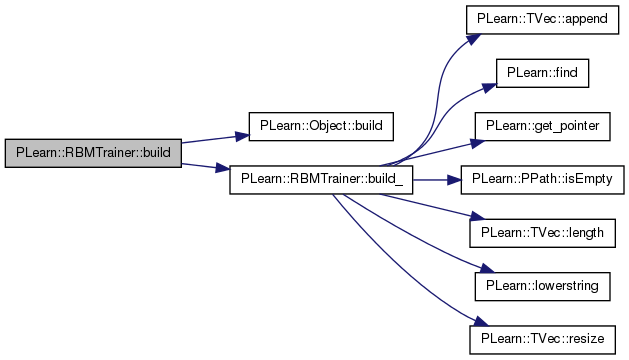
| void PLearn::RBMTrainer::build_ | ( | ) | [private] |
This does the actual building.
Reimplemented from PLearn::Object.
Definition at line 237 of file RBMTrainer.cc.
References PLearn::TVec< T >::append(), compute_log_likelihood, connection, data, data_filename, PLearn::find(), PLearn::get_pointer(), hidden, i, PLearn::PPath::isEmpty(), learning_rate, PLearn::TVec< T >::length(), PLearn::lowerstring(), n_hidden, n_ports, n_state_ports, n_test, n_train, n_valid, n_visible, nll_index, nll_values, PLCHECK, PLERROR, ports, rbm, rec_err_index, rec_err_values, PLearn::TVec< T >::resize(), seed, state_ports, state_ports_indices, test_input, train_input, use_fast_approximations, valid_input, visible, visible_index, and visible_type.
Referenced by build().
{
visible_type = lowerstring(visible_type);
PLCHECK( visible_type == "binomial" || visible_type == "gaussian" );
// visible
if (visible_type == "binomial")
visible = new RBMBinomialLayer();
else if (visible_type == "gaussian")
visible = new RBMGaussianLayer();
else
PLERROR("Unknown visible_type (%s).", visible_type.c_str());
visible->size = n_visible;
visible->setLearningRate(learning_rate);
visible->use_fast_approximations = use_fast_approximations;
visible->build();
// hidden
hidden = new RBMBinomialLayer();
hidden->size = n_hidden;
hidden->setLearningRate(learning_rate);
hidden->use_fast_approximations = use_fast_approximations;
hidden->build();
// connection
connection = new RBMMatrixConnection();
connection->down_size = n_visible;
connection->up_size = n_hidden;
connection->setLearningRate(learning_rate);
connection->use_fast_approximations = use_fast_approximations;
connection->build();
// RBM
rbm = new RBMModule();
rbm->visible_layer = visible;
rbm->hidden_layer = hidden;
rbm->connection = connection;
rbm->reconstruction_connection = connection;
rbm->compute_log_likelihood = compute_log_likelihood;
rbm->random_gen = new PRandom(seed);
rbm->cd_learning_rate = learning_rate;
rbm->use_fast_approximations = use_fast_approximations;
rbm->build();
// data
if (!data_filename.isEmpty())
{
PP<AutoVMatrix> data_ = new AutoVMatrix();
data_->filename = data_filename;
data_->defineSizes(n_visible, 1);
data_->build();
data = get_pointer(data_);
// train_input
train_input = new SubVMatrix(data, // source
0, // istart
0, // jstart
n_train, // length
n_visible, // width
true // call_build
);
// valid_input
valid_input = new SubVMatrix(data,
n_train,
0,
n_valid,
n_visible,
true
);
// valid_input
test_input = new SubVMatrix(data,
n_train + n_valid,
0,
n_test,
n_visible,
true
);
}
// ports
ports = rbm->getPorts();
n_ports = ports.length();
for (int i=0; i<n_ports; i++)
{
if (ports[i].find(".state", 0) != string::npos)
{
state_ports.append(ports[i]);
state_ports_indices.append(i);
}
}
n_state_ports = state_ports.length();
nll_index = rbm->getPortIndex("neg_log_likelihood");
visible_index = rbm->getPortIndex("visible");
rec_err_index = rbm->getPortIndex("reconstruction_error.state");
// nll_values
nll_values.resize(n_ports);
for (int i=0; i<n_state_ports; i++)
nll_values[state_ports_indices[i]] = new Mat();
// rec_err_values
rec_err_values.resize(n_ports);
for (int i=0; i<n_state_ports; i++)
rec_err_values[state_ports_indices[i]] = new Mat();
}
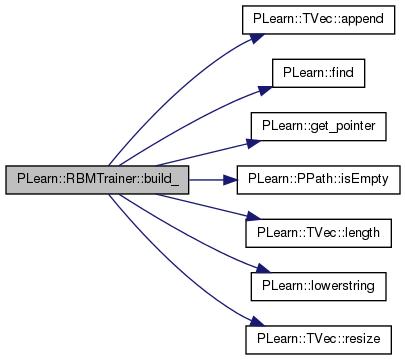

| void PLearn::RBMTrainer::CD1 | ( | const Mat & | examples | ) |
Definition at line 401 of file RBMTrainer.cc.
References connection, PLearn::endl(), h0, h0_a, h0_e, h0_s, hidden, PLearn::TMat< T >::length(), n_hidden, PLearn::pout, print_debug, rbm, PLearn::TMat< T >::resize(), sample_v1_in_chain, update_with_h0_sample, v1, v1_a, v1_e, v1_s, and visible.
Referenced by declareMethods(), and run().
{
int n_examples = examples.length();
if (print_debug)
{
pout << "v0 = " << endl << examples << endl;
}
// Positive phase
connection->setAsDownInputs(examples);
hidden->getAllActivations(connection, 0, true);
hidden->computeExpectations();
hidden->generateSamples();
h0_a = hidden->activations;
h0_s.resize(n_examples, n_hidden);
h0_s << hidden->samples.copy();
if (update_with_h0_sample)
{
h0 = h0_s;
}
else
{
h0_e.resize(n_examples, n_hidden);
h0_e << hidden->getExpectations();
h0 = h0_e;
}
if (print_debug)
{
pout << "h0_a = " << endl << h0_a << endl;
pout << "h0_e = " << endl << hidden->getExpectations() << endl;
pout << "h0_s = " << endl << h0_s << endl;
}
// Downward pass
connection->setAsUpInputs(h0_s);
visible->getAllActivations(connection, 0, true);
visible->computeExpectations();
visible->generateSamples();
v1_a = visible->activations;
v1_e = visible->getExpectations();
v1_s = visible->samples;
// Negative phase
if (sample_v1_in_chain)
v1 = v1_s;
else
v1 = v1_e;
if (print_debug)
{
pout << "v1_a = " << endl << v1_a << endl;
pout << "v1_e = " << endl << v1_e << endl;
pout << "v1_s = " << endl << v1_s << endl;
}
connection->setAsDownInputs(v1);
hidden->getAllActivations(connection, 0, true);
hidden->computeExpectations();
Mat h1 = hidden->getExpectations();
if (print_debug)
pout << "h1 = " << endl << h1 << endl;
rbm->CDUpdate(examples, h0, v1, h1);
}


| string PLearn::RBMTrainer::classname | ( | ) | const [virtual] |
Reimplemented from PLearn::Object.
Definition at line 56 of file RBMTrainer.cc.
| void PLearn::RBMTrainer::declareMethods | ( | RemoteMethodMap & | rmm | ) | [static, protected] |
Declare methods that are intended to be remote-callable.
If you use this mechanism, you don't usually need to override the call method in derived classes. The typical form of this method is as follows:
static void MyDerivedClass::declareMethods(RemoteMethodMap& rmm) { // Insert a backpointer to inherited methods; note that this // mechanism is different from that of declareOptions() rmm.inherited(inherited::_getRemoteMethodMap_()); // Mind the extra pair of parenthesis around the docstrings. // They are necessary for proper construction of documentation. declareMethod(rmm, "method1", &MyDerivedClass::method1, (BodyDoc("Main documentation for the method"), ArgDoc ("arg1_name", "Documentation for argument1"), ArgDoc ("arg2_name", "Documentation for argument2"), // ... other ArgDoc here ... RetDoc ("Documentation for the return value"))); // Other calls to declareMethod() as appropriate to expose the // public remote-callable interface }
IMPORTANT REMARKS:
The types of methods that can be directly declared in this manner is restricted to methods that don't have any "result-arguments" (and are either void, or *return* their result). But in C/C++ it is customary to implement "multiple results" by passing them as "result-arguments" to the call. You can't use declareMethod on such a method: you'll first have to write a wrapper method of the correct form that you can declare with declareMethod. To *return* multiple results, you should actually return a *tuple*.
Ex: if you have a method of class PLearner with 2 "result arguments" like:
virtual void computeOutputAndCosts(const Vec& input, const Vec& target, Vec& output, Vec& costs) const;
you can't declare it directly with declareMethod, so you'll have to write a wrapper-method that you can declare, like the following:
tuple<Vec,Vec> PLearner::remote_computeOutputAndCosts(const Vec& input, const Vec& target) const { Vec output; Vec costs; computeOutputAndCosts(input,target,output,costs); return make_tuple(output, costs); }
The policy is to name such wapper methods destined for the remote method mechanism by prepending the suffix remote_, and usually to keep them private and non-virtual.
Note that from the calling-convention perspective of a C++ process remote-calling such a tuple-returning method, the results will be received as "multiple results" corresponding to the elements of the tuple, rather than as a "single result" of type tuple. If instead you *really* want your tuple to be received as a single tuple then you should return a tuple of your tuple.
Also beware, if you have several C++ methods with the same name, overloaded for different types of arguments, and you want to make them all remote callable, you should declare them with *different* corresponding string names in declareMethods. Indeed, the remote method mechanism can only distinguish methods based on their string name and number of arguments, but not on the types of the arguments.
| rmm | RemoteMethodMap to be constructed for the current class. |
Reimplemented from PLearn::Object.
Definition at line 215 of file RBMTrainer.cc.
References PLearn::Object::_getRemoteMethodMap_(), CD1(), PLearn::declareMethod(), PLearn::RemoteMethodMap::inherited(), NLL(), and recError().
{
// Make sure that inherited methods are declared
rmm.inherited(inherited::_getRemoteMethodMap_());
declareMethod(rmm, "NLL", &RBMTrainer::NLL,
(BodyDoc("Computes NLL"),
ArgDoc ("examples", "The examples"),
RetDoc ("The NLL")
));
declareMethod(rmm, "recError", &RBMTrainer::recError,
(BodyDoc("Computes reconstruction error"),
ArgDoc ("examples", "The examples"),
RetDoc ("The reconstruction error")
));
declareMethod(rmm, "CD1", &RBMTrainer::CD1,
(BodyDoc("Performs one step of CD"),
ArgDoc ("examples", "The examples")));
}

| void PLearn::RBMTrainer::declareOptions | ( | OptionList & | ol | ) | [static, protected] |
Declares the class options.
Reimplemented from PLearn::Object.
Definition at line 96 of file RBMTrainer.cc.
References batch_size, PLearn::OptionBase::buildoption, compute_log_likelihood, connection, data, data_filename, PLearn::declareOption(), PLearn::Object::declareOptions(), hidden, learning_rate, PLearn::OptionBase::learntoption, n_hidden, n_stages, n_test, n_train, n_valid, n_visible, print_debug, rbm, sample_v1_in_chain, save_name, save_path, seed, test_input, train_input, update_with_h0_sample, use_fast_approximations, valid_input, visible, and visible_type.
{
declareOption(ol, "n_visible", &RBMTrainer::n_visible,
OptionBase::buildoption,
"n_visible");
declareOption(ol, "n_hidden", &RBMTrainer::n_hidden,
OptionBase::buildoption,
"n_hidden");
declareOption(ol, "visible_type", &RBMTrainer::visible_type,
OptionBase::buildoption,
"visible_type");
declareOption(ol, "update_with_h0_sample",
&RBMTrainer::update_with_h0_sample,
OptionBase::buildoption,
"update_with_h0_sample");
declareOption(ol, "sample_v1_in_chain", &RBMTrainer::sample_v1_in_chain,
OptionBase::buildoption,
"sample_v1_in_chain");
declareOption(ol, "compute_log_likelihood",
&RBMTrainer::compute_log_likelihood,
OptionBase::buildoption,
"compute_log_likelihood");
declareOption(ol, "n_stages", &RBMTrainer::n_stages,
OptionBase::buildoption,
"n_stages");
declareOption(ol, "learning_rate", &RBMTrainer::learning_rate,
OptionBase::buildoption,
"learning_rate");
declareOption(ol, "seed", &RBMTrainer::seed,
OptionBase::buildoption,
"seed");
declareOption(ol, "n_train", &RBMTrainer::n_train,
OptionBase::buildoption,
"n_train");
declareOption(ol, "n_valid", &RBMTrainer::n_valid,
OptionBase::buildoption,
"n_valid");
declareOption(ol, "n_test", &RBMTrainer::n_test,
OptionBase::buildoption,
"n_test");
declareOption(ol, "batch_size", &RBMTrainer::batch_size,
OptionBase::buildoption,
"batch_size");
declareOption(ol, "data_filename", &RBMTrainer::data_filename,
OptionBase::buildoption,
"data_filename");
declareOption(ol, "save_path", &RBMTrainer::save_path,
OptionBase::buildoption,
"save_path");
declareOption(ol, "save_name", &RBMTrainer::save_name,
OptionBase::buildoption,
"save_name");
declareOption(ol, "print_debug", &RBMTrainer::print_debug,
OptionBase::buildoption,
"print_debug");
declareOption(ol, "use_fast_approximations",
&RBMTrainer::use_fast_approximations,
OptionBase::buildoption,
"use_fast_approximations");
declareOption(ol, "data", &RBMTrainer::data,
OptionBase::learntoption,
"data");
declareOption(ol, "train_input", &RBMTrainer::train_input,
OptionBase::learntoption,
"train_input");
declareOption(ol, "valid_input", &RBMTrainer::valid_input,
OptionBase::learntoption,
"valid_input");
declareOption(ol, "test_input", &RBMTrainer::test_input,
OptionBase::learntoption,
"test_input");
declareOption(ol, "rbm", &RBMTrainer::rbm,
OptionBase::learntoption,
"rbm");
declareOption(ol, "visible", &RBMTrainer::visible,
OptionBase::learntoption,
"visible");
declareOption(ol, "hidden", &RBMTrainer::hidden,
OptionBase::learntoption,
"hidden");
declareOption(ol, "connection", &RBMTrainer::connection,
OptionBase::learntoption,
"connection");
/*
declareOption(ol, "", &RBMTrainer::,
OptionBase::learntoption,
"");
*/
// Now call the parent class' declareOptions
inherited::declareOptions(ol);
}

| static const PPath& PLearn::RBMTrainer::declaringFile | ( | ) | [inline, static] |
Reimplemented from PLearn::Object.
Definition at line 106 of file RBMTrainer.h.
:
//##### Protected Options ###############################################
| RBMTrainer * PLearn::RBMTrainer::deepCopy | ( | CopiesMap & | copies | ) | const [virtual] |
Reimplemented from PLearn::Object.
Definition at line 56 of file RBMTrainer.cc.
| OptionList & PLearn::RBMTrainer::getOptionList | ( | ) | const [virtual] |
Reimplemented from PLearn::Object.
Definition at line 56 of file RBMTrainer.cc.
| OptionMap & PLearn::RBMTrainer::getOptionMap | ( | ) | const [virtual] |
Reimplemented from PLearn::Object.
Definition at line 56 of file RBMTrainer.cc.
| RemoteMethodMap & PLearn::RBMTrainer::getRemoteMethodMap | ( | ) | const [virtual] |
Reimplemented from PLearn::Object.
Definition at line 56 of file RBMTrainer.cc.
| void PLearn::RBMTrainer::makeDeepCopyFromShallowCopy | ( | CopiesMap & | copies | ) | [virtual] |
Transforms a shallow copy into a deep copy.
Reimplemented from PLearn::Object.
Definition at line 89 of file RBMTrainer.cc.
References PLearn::Object::makeDeepCopyFromShallowCopy().
{
inherited::makeDeepCopyFromShallowCopy(copies);
// deepCopyField(trainvec, copies);
}

Definition at line 347 of file RBMTrainer.cc.
References PLearn::endl(), i, PLearn::TMat< T >::length(), n_state_ports, nll_index, nll_values, PLASSERT, PLearn::pout, print_debug, rbm, PLearn::TVec< T >::size(), state_ports_indices, visible_index, and PLearn::TMat< T >::width().
Referenced by declareMethods(), and run().
{
Mat nll;
for (int i=0; i<n_state_ports; i++)
nll_values[state_ports_indices[i]]->resize(0,0);
nll_values[nll_index] = &nll;
nll_values[visible_index] = const_cast<Mat *>(&examples);
rbm->fprop(nll_values);
if (print_debug)
{
pout << "In NLL:" << endl;
for (int i=0; i<n_state_ports; i++)
{
int portnum = state_ports_indices[i];
string portname = rbm->getPortName(portnum);
pout << portname << ": " << nll_values[portnum]->size() << endl;
}
}
PLASSERT(nll.length() == examples.length() && nll.width() == 1);
return nll;
}


Definition at line 374 of file RBMTrainer.cc.
References PLearn::endl(), i, PLearn::TMat< T >::length(), n_state_ports, PLASSERT, PLearn::pout, print_debug, rbm, rec_err_index, rec_err_values, PLearn::TVec< T >::size(), state_ports_indices, visible_index, and PLearn::TMat< T >::width().
Referenced by declareMethods(), and run().
{
Mat rec_err;
for (int i=0; i<n_state_ports; i++)
rec_err_values[state_ports_indices[i]]->resize(0,0);
rec_err_values[rec_err_index] = &rec_err;
rec_err_values[visible_index] = const_cast<Mat *>(&examples);
rbm->fprop(rec_err_values);
if (print_debug)
{
pout << "In recError:" << endl;
for (int i=0; i<n_state_ports; i++)
{
int portnum = state_ports_indices[i];
string portname = rbm->getPortName(portnum);
pout << portname << ": " << rec_err_values[portnum]->size() << endl;
}
}
PLASSERT(rec_err.length() == examples.length()
&& rec_err.width() == 1);
return rec_err;
}


| void PLearn::RBMTrainer::run | ( | ) | [virtual] |
Override this for runnable objects (default method issues a runtime error).
Runnable objects are objects that can be used as *THE* object of a .plearn script. The run() method specifies what they should do when executed.
Reimplemented from PLearn::Object.
Definition at line 471 of file RBMTrainer.cc.
References batch_size, CD1(), PLearn::endl(), i, PLearn::PPath::isEmpty(), PLearn::mean(), n_stages, n_test, n_train, n_valid, NLL(), PLearn::openFile(), PLearn::pout, PLearn::PStream::raw_ascii, recError(), save_name, save_path, PLearn::VMat::subMatRows(), test_input, train_input, and valid_input.
{
Mat results(n_stages+1, 6);
for (int stage=0; stage<n_stages; stage++)
{
pout << "stage: " << stage << endl;
results(stage, 0) = mean(NLL(train_input));
results(stage, 3) = mean(recError(train_input));
if (n_valid > 0)
{
results(stage, 1) = mean(NLL(valid_input));
results(stage, 4) = mean(recError(valid_input));
}
if (n_test > 0)
{
results(stage, 2) = mean(NLL(test_input));
results(stage, 5) = mean(recError(test_input));
}
pout << "NLL: " << results(stage).subVec(0,3) << endl;
pout << "RecError: " << results(stage).subVec(3,3) << endl;
for (int i=0; i<n_train/batch_size; i++)
CD1(train_input.subMatRows(i*batch_size, batch_size));
}
pout << "stage: " << n_stages << endl;
results(n_stages, 0) = mean(NLL(train_input));
results(n_stages, 3) = mean(recError(train_input));
if (n_valid > 0)
{
results(n_stages, 1) = mean(NLL(valid_input));
results(n_stages, 4) = mean(recError(valid_input));
}
if (n_test > 0)
{
results(n_stages, 2) = mean(NLL(test_input));
results(n_stages, 5) = mean(recError(test_input));
}
pout << "NLL: " << results(n_stages).subVec(0,3) << endl;
pout << "RecError: " << results(n_stages).subVec(3,3) << endl;
pout << "results = " << endl << results << endl;
if (!save_path.isEmpty())
{
PPath filename;
if (save_name.isEmpty())
filename = save_path / "results.amat";
else
filename = save_path / save_name;
PStream file = openFile(filename, PStream::raw_ascii, "w");
file << results << endl;
}
}
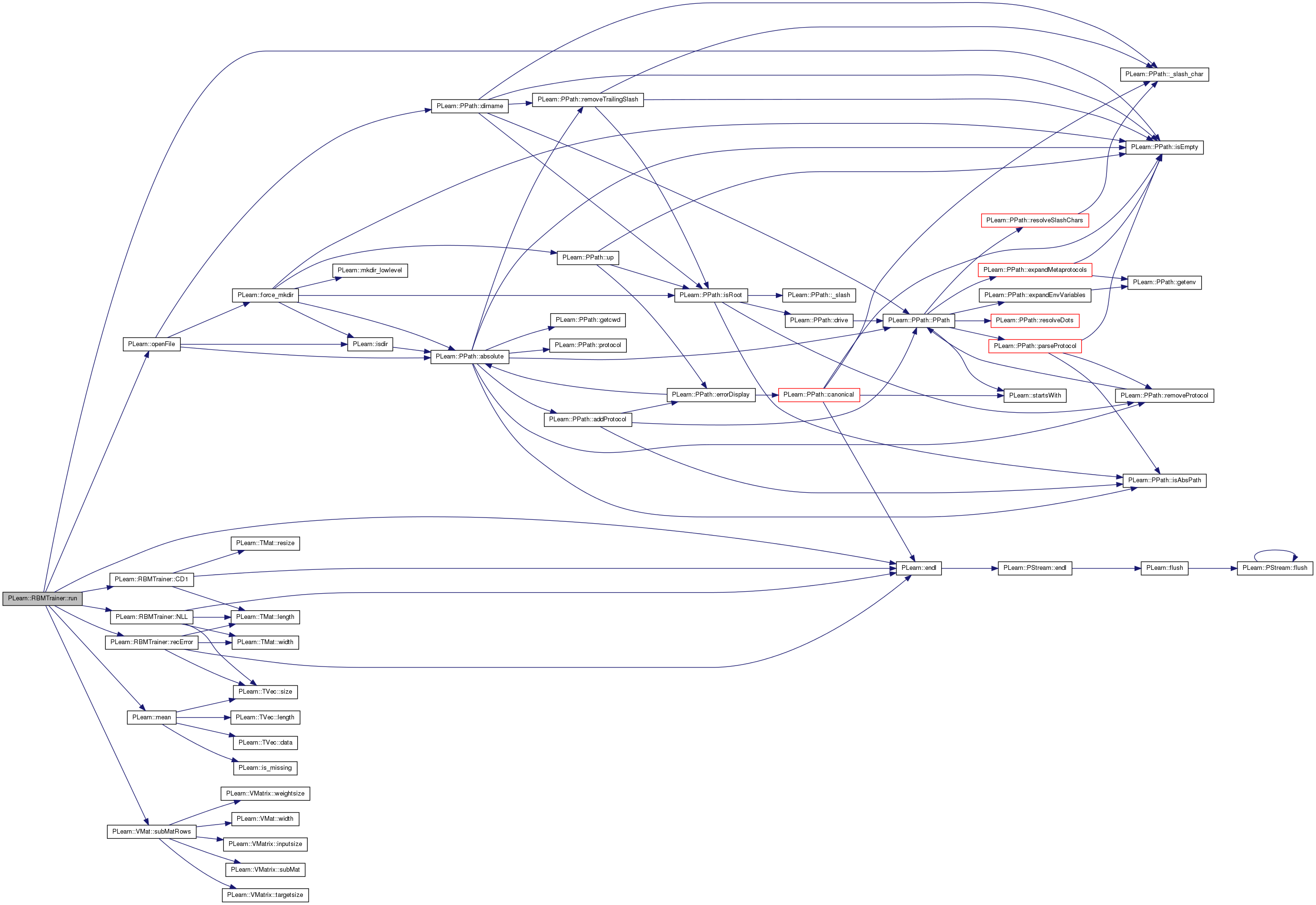
Reimplemented from PLearn::Object.
Definition at line 106 of file RBMTrainer.h.
Definition at line 80 of file RBMTrainer.h.
Referenced by declareOptions(), and run().
Definition at line 73 of file RBMTrainer.h.
Referenced by build_(), and declareOptions().
PP<RBMConnection> PLearn::RBMTrainer::connection [protected] |
Definition at line 127 of file RBMTrainer.h.
Referenced by build_(), CD1(), and declareOptions().
VMat PLearn::RBMTrainer::data [protected] |
Definition at line 119 of file RBMTrainer.h.
Referenced by build_(), and declareOptions().
Definition at line 81 of file RBMTrainer.h.
Referenced by build_(), and declareOptions().
Mat PLearn::RBMTrainer::h0 [mutable, private] |
Definition at line 162 of file RBMTrainer.h.
Referenced by CD1().
Mat PLearn::RBMTrainer::h0_a [mutable, private] |
Definition at line 159 of file RBMTrainer.h.
Referenced by CD1().
Mat PLearn::RBMTrainer::h0_e [mutable, private] |
Definition at line 160 of file RBMTrainer.h.
Referenced by CD1().
Mat PLearn::RBMTrainer::h0_s [mutable, private] |
Definition at line 161 of file RBMTrainer.h.
Referenced by CD1().
PP<RBMLayer> PLearn::RBMTrainer::hidden [protected] |
Definition at line 126 of file RBMTrainer.h.
Referenced by build_(), CD1(), and declareOptions().
Definition at line 75 of file RBMTrainer.h.
Referenced by build_(), and declareOptions().
Definition at line 69 of file RBMTrainer.h.
Referenced by build_(), CD1(), and declareOptions().
int PLearn::RBMTrainer::n_ports [protected] |
Definition at line 131 of file RBMTrainer.h.
Referenced by build_().
Definition at line 74 of file RBMTrainer.h.
Referenced by declareOptions(), and run().
int PLearn::RBMTrainer::n_state_ports [protected] |
Definition at line 132 of file RBMTrainer.h.
Referenced by build_(), NLL(), and recError().
Definition at line 79 of file RBMTrainer.h.
Referenced by build_(), declareOptions(), and run().
Definition at line 77 of file RBMTrainer.h.
Referenced by build_(), declareOptions(), and run().
Definition at line 78 of file RBMTrainer.h.
Referenced by build_(), declareOptions(), and run().
### declare public option fields (such as build options) here Start your comments with Doxygen-compatible comments such as //!
Definition at line 68 of file RBMTrainer.h.
Referenced by build_(), and declareOptions().
int PLearn::RBMTrainer::nll_index [protected] |
Definition at line 134 of file RBMTrainer.h.
TVec<Mat*> PLearn::RBMTrainer::nll_values [mutable, private] |
Definition at line 156 of file RBMTrainer.h.
TVec<string> PLearn::RBMTrainer::ports [protected] |
Definition at line 129 of file RBMTrainer.h.
Referenced by build_().
Definition at line 84 of file RBMTrainer.h.
Referenced by CD1(), declareOptions(), NLL(), and recError().
PP<RBMModule> PLearn::RBMTrainer::rbm [protected] |
Definition at line 124 of file RBMTrainer.h.
Referenced by build_(), CD1(), declareOptions(), NLL(), and recError().
int PLearn::RBMTrainer::rec_err_index [protected] |
Definition at line 136 of file RBMTrainer.h.
Referenced by build_(), and recError().
TVec<Mat*> PLearn::RBMTrainer::rec_err_values [mutable, private] |
Definition at line 157 of file RBMTrainer.h.
Referenced by build_(), and recError().
Definition at line 72 of file RBMTrainer.h.
Referenced by CD1(), and declareOptions().
Definition at line 83 of file RBMTrainer.h.
Referenced by declareOptions(), and run().
Definition at line 82 of file RBMTrainer.h.
Referenced by declareOptions(), and run().
| int32_t PLearn::RBMTrainer::seed |
Definition at line 76 of file RBMTrainer.h.
Referenced by build_(), and declareOptions().
TVec<string> PLearn::RBMTrainer::state_ports [protected] |
Definition at line 130 of file RBMTrainer.h.
Referenced by build_().
TVec<int> PLearn::RBMTrainer::state_ports_indices [protected] |
Definition at line 133 of file RBMTrainer.h.
Referenced by build_(), NLL(), and recError().
VMat PLearn::RBMTrainer::test_input [protected] |
Definition at line 122 of file RBMTrainer.h.
Referenced by build_(), declareOptions(), and run().
VMat PLearn::RBMTrainer::train_input [protected] |
Definition at line 120 of file RBMTrainer.h.
Referenced by build_(), declareOptions(), and run().
Definition at line 71 of file RBMTrainer.h.
Referenced by CD1(), and declareOptions().
Definition at line 85 of file RBMTrainer.h.
Referenced by build_(), and declareOptions().
Mat PLearn::RBMTrainer::v1 [mutable, private] |
Definition at line 167 of file RBMTrainer.h.
Referenced by CD1().
Mat PLearn::RBMTrainer::v1_a [mutable, private] |
Definition at line 164 of file RBMTrainer.h.
Referenced by CD1().
Mat PLearn::RBMTrainer::v1_e [mutable, private] |
Definition at line 165 of file RBMTrainer.h.
Referenced by CD1().
Mat PLearn::RBMTrainer::v1_s [mutable, private] |
Definition at line 166 of file RBMTrainer.h.
Referenced by CD1().
VMat PLearn::RBMTrainer::valid_input [protected] |
Definition at line 121 of file RBMTrainer.h.
Referenced by build_(), declareOptions(), and run().
PP<RBMLayer> PLearn::RBMTrainer::visible [protected] |
Definition at line 125 of file RBMTrainer.h.
Referenced by build_(), CD1(), and declareOptions().
int PLearn::RBMTrainer::visible_index [protected] |
Definition at line 135 of file RBMTrainer.h.
Referenced by build_(), NLL(), and recError().
Definition at line 70 of file RBMTrainer.h.
Referenced by build_(), and declareOptions().
 1.7.4
1.7.4